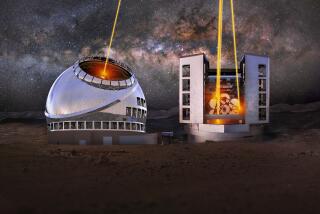Leonard Searle dies at 79; astronomer’s work provided key information on the Big Bang
- Share via
Astronomer Leonard Searle, a former director of the Carnegie Observatories whose observations provided crucial information in determining the conditions of the Big Bang that created the universe and helped explain how heavy elements are produced in stars, has died. He was 79.
Searle died July 2 at his home in Pasadena, according to the Carnegie Institution for Science in Washington, D.C. No cause of death was released.
Searle also played a crucial role in the construction of the twin 6.5-meter (255-inch) Magellan telescopes at Carnegie’s Las Campanas Observatory in Chile, which opened in 2000 and are generally considered to be the best natural imaging telescopes in the world.
FOR THE RECORD:The obituary in Friday’s LATExtra section of Leonard Searle, an astronomer and former director of the Carnegie Observatories, mistakenly referred to his Carnegie colleague George Preston as Robert Preston.
He was “a thoughtful man who chose his problems carefully,” said astronomer Robert Preston, a director emeritus of the Carnegie Observatories. “The things that he accomplished were of lasting value; they’re still used today.”
The Big Bang was a singularity that started the formation of the universe and researchers have been curious about the precise conditions that existed during the explosion. That event produced massive numbers of elementary particles that, as the gas expanded and cooled, condensed to form hydrogen, helium and trace amounts of lithium and beryllium. All the rest of the elements in the universe were subsequently created in the nuclear furnaces of stars.
To calculate the temperature and pressure that existed in the Big Bang, it is crucial to know the ratio of helium to hydrogen that existed immediately afterward, and that was a problem Searle and Wallace Sargent attacked.
Most old stars are too cool to cause helium to fluoresce, so it is not possible to measure their helium-to-hydrogen ratio. And in even the hottest old stars, helium has diffused inward to the core, diluting the concentration at the surface and providing a false value for the ratio.
Ultimately, the pair identified small galaxies with slow star formation rates whose helium-to-hydrogen ratios were probably very similar to those at the creation of the universe. The values they obtained are still used in modeling the conditions of the Big Bang.
“That was typical of Leonard,” Preston said. “He didn’t write lots of papers. He settled on issues of fundamental importance, studied them carefully and then wrote them up. He produced a relatively small number of papers whose impact on the field is large.”
Searle and Sargent also developed a model of how hydrogen and helium in the nuclear reactors of stars fused to form all the other heavier elements, a process called chemical evolution. Others termed it the “simple model” because of its clarity and it is still used today to characterize the way a galaxy produces elements and transforms gases into stars.
Searle may be best known for his work, with Robert Zinn, now at Yale University, on how galaxies are formed. Most astronomers had originally believed that galaxies condensed from massive clusters of gas in a uniform process. But by studying small galaxies near the outer fringes of our own Milky Way galaxy, the pair concluded that galaxies grew by swallowing smaller galaxies, so-called primordial fragments.
That process is now the accepted mechanism for galaxy formation and has been verified in many other experiments.
Leonard Searle was born Oct. 23, 1930, in the London suburb of Mitcham. He received his bachelor’s degree from the University of St. Andrews in Scotland and his doctorate in theoretical physics from Princeton University.
His first post was at the University of Toronto, but he left in 1960 to join Caltech. Three years later, he joined the faculty of the Mount Stromblo Observatory in Australia. Finally, in 1968, he returned to Pasadena to join the Carnegie Observatories, where he spent the rest of his career.
Searle’s wife of 47 years, the former Eleanor Millard, died in 1999. He has no surviving relatives.
More to Read
Start your day right
Sign up for Essential California for the L.A. Times biggest news, features and recommendations in your inbox six days a week.
You may occasionally receive promotional content from the Los Angeles Times.




